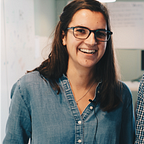From Pre-Idea Entrepreneurs to Pre-Seed Ventures
A few months ago, I met a graduate student who desperately wanted to be an entrepreneur. He would schedule time to sit and think, focusing intently and hoping to stumble upon the ever-elusive “A-HA!” moment. There are hundreds of aspiring entrepreneurs in South Bend who, like that student, see their only path to entrepreneurship starting with the magical moment when they have an idea. If an idea does come to them, more often than not, it is one that solves a problem for them and people like them. This approach to idea generation centers solutions around the problem of an individual and does not often yield ventures that solve systems level problems which view that problem in the context of a more complex landscape. Depending on who the aspiring entrepreneur is, they also risk solving problems that only affect the tiny sliver of the population who shares their background.
We are starting to see proof from the Venture Founder Program that a radically different approach to idea generation is possible. And it happens to be producing exactly the kind of systems level ventures that are so elusive to a lone entrepreneur who sits waiting for an idea to strike. Why do I think it might be working?
Here are six anecdotal reasons to think we might be on to something — taken straight from the experiences of our six founders:
1) A woman at the chamber of commerce cuts you off in the middle of explaining what you’re working on to offer you a job.
2) A hospital stewardship manager eagerly gives you a sample data set to use as you build your first prototype.
3) A general partner at a private equity firm exchanges excited text messages with you about your idea.
4) You get a phone call from someone you don’t know inviting you to a happy hour with 10 of the biggest players on your customer segment hit list. Happy hour turns into Happy Four Hours.
5) One of your key stakeholders schedules weekly co-creation meetings with you and at times appears more excited about your idea than you are yourself.
6) Ecosystem actors start talking about how they can incentivize you to stay in the area and launch your venture in May.
How did they get to a place so different than that graduate student, who is still devoting time to think his way to a big idea?
They started by building out a systems map and identifying the key stakeholders that interact with the problem areas they defined in their problem pitches. Research that started behind their computer screens quickly moved into hospitals, manufacturing floors, government offices, and coffee shops. They zoomed out to understand the flow of people, money, and resources between key stakeholders and zoomed in to uncover the incentives of individual decision makers within an organization. They shaped a systemic view of a big problem, while simultaneously hunting for entrepreneurial opportunities. As they walked through their systems maps they were constantly asking themselves two questions:
· Is there an opportunity here to create impact? For whom?
· Is there an opportunity here for a sustainable business model? With whom?
They went on to build beautiful cases for the impact and scale of their specific opportunity areas, in such a way that those of us listening wanted to know how they were going to act on it!
Instead of latching on to the first idea that came to mind, the founders took a disciplined human-centered approach to developing solutions that really attacked the core of their problem areas in the context of their systems. The founders have shown a healthy willingness to quickly learn and pivot from ideas as soon as they have a good reason, a tendency which I believe is deeply tied to the allegiance they feel to solving a problem instead of an allegiance to a particular idea. In the month after their opportunity pitches they performed customer interviews, distilled them into insights, built prototypes and absorbed feedback. They each then gave venture pitches — and for the first time they weren’t working off of a template we created to reflect the wild west of pre-idea entrepreneurship. They were giving a proper venture pitch and their ventures had to stand up to the same rigorous analysis of any venture that would come across an investor’s desk. We are beyond excited with where their ventures are headed.
Fintus
Fintus improves people’s financial health while lowering banks’ customer acquisition and transaction costs through gamified digital literacy training and mobile banking.
Manufacture America
Manufacture America is a customizable pipeline for skilled labor that uses guaranteed job placement to incentivize the completion of hard and soft skills training programs, allowing manufacturers to fill jobs with people prepared to contribute to, and benefit from, their long-term health.
Care Fleet
Care Fleet provides a simplified transportation solution for non-profits that help low-income, chronic disease patients attend medical appointments, eliminating the transportation barrier and thereby improving health outcomes.
Moving forward, it is time for the founders to start building. They have defined the value propositions for their various customer segments and put time into thinking about operational models and channels. Now comes the time to prototype the guts of their solutions. What are the nuts and bolts of what the ventures actually do? How do you build the best, first version? How do we get these early solutions in front of real customers? I can’t wait to find out.
